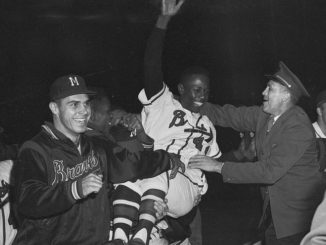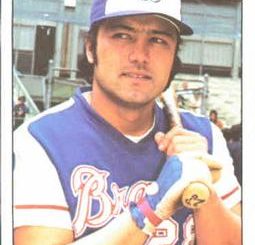One frustration for Braves fans is that big, historical single-game feats just don’t come to us as often. In the past 23 seasons, here are teams who have enjoyed a no-hitter or a 4-HR game.
- Arizona
- Boston
- Chicago Cubs
- Chicago White Sox
- Cincinnati
- Colorado
- Detroit
- Houston
- LA Angels
- LA Dodgers
- Miami
- Minnesota
- New York Mets
- New York Yankees
- Oakland
- Philadelphia
- Pittsburgh
- St. Louis
- San Francisco
- Seattle
- Tampa Bay
- Texas
- Toronto
- Washington
That leaves 6 teams: Kansas City, Milwaukee, San Diego, Baltimore, Cleveland, and Atlanta.

Atlanta’s last no-hitter was thrown in April of 1994, by the best Brave to ever wear #50: Kent Mercker.
The 5th overall pick of the 1986 draft, Mercker played his first full season in 1988 and impressed at high-A and AA, combining to go 14-5 with a 2.91 ERA and 219 Ks in 175.1 innings. Baseball America named him the #2 prospect in the Atlanta system the following offseason, and after the 21-year old had a 3.20 ERA across 168.2 AAA innings in 1989, the publication ranked him the #47 prospect in baseball.
Mercker got a cup of coffee with the big league club in ’89, and after another half season in AAA in 1990, was brought up for good. Interestingly, after a stellar MiLB career as a starter, the 1990 Braves exclusively relied on Mercker as a reliever. He performed well in 36 games, posting a 3.17 ERA and 7 saves. Thanks to Atlanta’s wealth of pitching talent, Mercker was relegated to the bullpen throughout the emergence of the Atlanta dynasty, making spot starts here and there. Mercker picked up 6 saves for the 1991 Worst-to-First Braves, with a 2.58 ERA. He only made 4 starts, but one turned into something special:
From 1992-1993 Mercker continued to be reliable, even if he wasn’t quite as good. In those two seasons, he threw 134.1 innings with a 3.15 ERA and 6 saves.
In 1994, longtime 5th starter Pete Smith was now a Met, so Mercker finally got his crack at the rotation. In his first start of the season, he let the Braves know what they had missed:
It wasn’t a singular outlier of a start, either. Mercker went 9-4 with a 3.45 ERA and 111 Ks in 112.1 innings that summer. During a year which really vaulted the 90’s further into the era of offensive explosion, that was an impressive feat. Unfortunately for Mercker, the MLBPA strike cut short what was easily the best season of his career. He couldn’t get his groove back in 1995 and was traded after the 1995 season to Baltimore (for Joe Borowski and a guy literally named Chaad Stewart – that’s not a typo).
From there, Mercker became a journeyman, the swingman lefty every team could find room for but none felt compelled to keep. After struggling badly with the Orioles, the team dealt Mercker halfway through 1996 to Cleveland for 40 year old Eddie Murray. He signed with Cincinnati in the offseason, and thanks to some BABIP luck managed a 3.92 ERA for the ’97 Reds. Again a free agent, he signed with St. Louis, and the BABIP luck ran out in 1998. ’99 was no better, so the Cards shipped him up to Boston in August for a couple of prospects. After a few weeks in Beantown, Mercker again hit free agency and signed a one year deal with Anaheim. 48 1/3 innings of 6.52 ERA ball later, the Angels had seen enough. He went back to Boston in the offseason on a spring training invite, but was cut in late March. He resurfaced in 2002 with the Rockies, but he still struggled (6.14 ERA in 44 innings). In 2003, Mercker went back to the Reds (he’s an Ohio native), and something finally clicked – perhaps it was the # on his back, as he went back to #50 for the first time since his Braves days. In 38.1 innings, he had a 2.35 ERA with 41 Ks. It was such a bounceback, Mercker caught the eye of a contender, his original club, the Atlanta Braves.
Thanks to a .241 BABIP, Mercker rewarded the 2003 Braves for their trade with a 1.06 ERA in 17 innings. He even pitched a scoreless frame in the LDS against the Cubs. It was a nice reunion (although it cost Atlanta the immortal rubber arm of Matt Belisle).
From there, Mercker signed with the Cubs and had another nice season in ’04 (2.55 in 53 IP). He followed that with a nice 2005 for the Reds (3.65 in 67.2 IP). 2006 inched closer to mediocrity (4.13 in 28.1), and Mercker missed ’07. In 2008, he again signed with Cincinnati and pitched 13.2 innings at a 3.29 ERA to close out his MLB career.
After retirement, Mercker joined the Reds’ broadcast team.
Who Is the Best Ever To Wear #50?
It’s a tough choice, but I’m going with Jamie Moyer, who wore it from 1996 through the end of his career. Adam Wainwright has also had success, but I think Moyer’s peak (’97-’03) rivals Wainwright’s, and Moyer has longevity to boot.




Leave a Reply